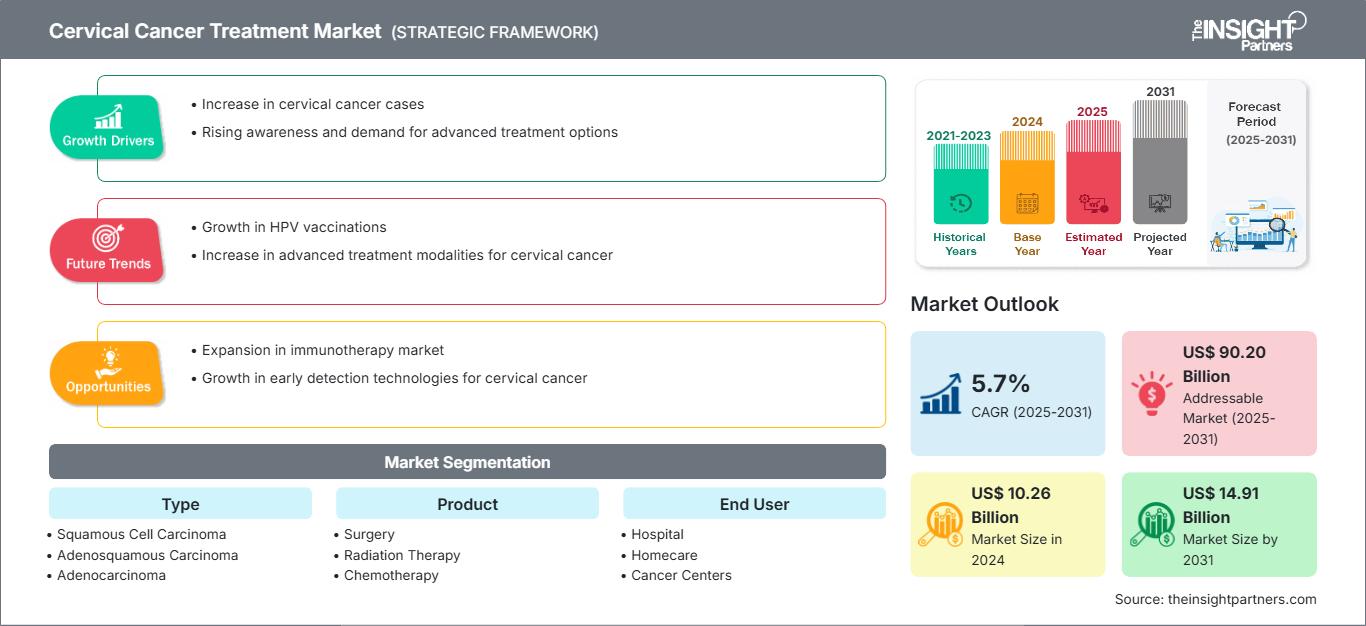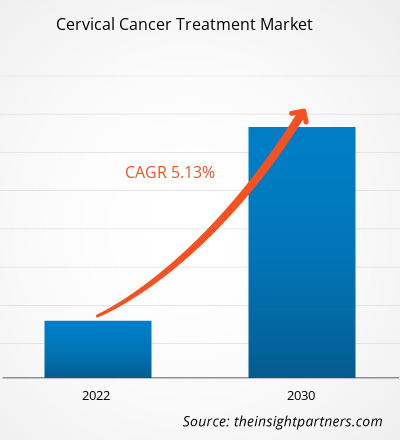[Rapporto di ricerca] Si prevede che il mercato dei trattamenti per il cancro cervicale crescerà da 10,26 miliardi di dollari nel 2024 a 14,91 miliardi di dollari entro il 2031; si prevede che il mercato registrerà un CAGR del 5,7% dal 2025 al 2031.
Approfondimenti di mercato e punto di vista degli analisti:
Le previsioni di mercato per il trattamento del cancro cervicale possono aiutare gli stakeholder a pianificare le proprie strategie di crescita.
Il cancro cervicale si riferisce al tumore che si sviluppa nelle cellule della cervice, ovvero la parte inferiore dell'utero che si collega alla vagina. Nel 90% dei casi, le neoplasie cervicali si verificano a causa dell'infezione da HPV e vengono diagnosticate tramite Pap test. La crescente prevalenza del cancro cervicale e l'aumento delle infezioni da HPV sono i fattori chiave che guidano la crescita del mercato dei trattamenti per il cancro cervicale. Tuttavia, la scarsa consapevolezza sui metodi di diagnosi e trattamento ostacola la crescita del mercato. Le tendenze del mercato del trattamento del cancro cervicale includono l'aumento della ricerca e sviluppo per la diagnosi e i farmaci per il cancro cervicale.
Fattori di crescita e sfide:
La crescente prevalenza del cancro cervicale alimenta il mercato del trattamento del cancro cervicale
In tutto il mondo, il cancro sta diventando una delle principali cause di mortalità. Secondo l'Organizzazione Mondiale della Sanità (OMS), il cancro è stata la principale causa di morte per le persone di età inferiore ai 70 anni in 183 nazioni, mentre in altri 123 paesi è stata la quarta causa di morte più comune a livello globale nel 2019. Inoltre, secondo i dati pubblicati dall'Organizzazione Mondiale della Sanità a marzo 2021, quasi 10 milioni di decessi nel 2020 sono stati attribuiti a varie forme di cancro. Il mercato in esame ha registrato una significativa espansione, che può essere collegata alla crescente incidenza del cancro cervicale tra le donne in tutto il mondo. Secondo l'Organizzazione Mondiale della Sanità (OMS), il cancro cervicale uccide oltre 270.000 donne ogni anno. I tassi di mortalità per cancro cervicale sono elevati nei paesi più poveri a causa della tardiva scoperta della malattia.
La crescente prevalenza del cancro cervicale ha creato un onere per i sistemi sanitari di tutto il mondo. Secondo l'Agenzia Internazionale per la Ricerca sul Cancro (IARC), si stima che il numero globale di nuovi casi di cancro raggiungerà circa 27,5 milioni e che la malattia causerà probabilmente circa 163 milioni di decessi entro il 2040. Si prevede che fattori come cambiamenti nello stile di vita, fumo, riduzione dell'attività fisica e condizioni climatiche e sanitarie incerte aumenteranno l'incidenza del cancro nel mondo nei prossimi anni. Pertanto, è essenziale controllare e prevenire il crescente numero di tumori in tutto il mondo.
La scarsa consapevolezza sul cancro cervicale tra la popolazione, gli operatori sanitari e i responsabili politici; l'accesso limitato a servizi sanitari di alta qualità e programmi di screening cervicale; e la mancanza di sistemi di riferimento funzionali sono tra i fattori che determinano l'elevata incidenza e mortalità per cancro cervicale. L'incidenza e la mortalità per cancro cervicale sono diminuite nei paesi industrializzati grazie al migliore accesso allo screening citologico e al trattamento rapido delle lesioni cervicali precoci. È fondamentale implementare lo screening cervicale basato sulla popolazione e aumentarne l'accettazione nei paesi a basso e medio reddito (LMIC) per ridurre la mortalità per cancro cervicale. Aumentare la consapevolezza sui fattori di rischio come il primo rapporto sessuale in giovane età e la presenza di più partner sessuali maschili; l'alto rischio associato ai tipi di HPV 8, 9 e 10; la prima gravidanza a termine in giovane età; l'uso prolungato di contraccettivi orali; e le infezioni da HIV può contribuire ad aumentare la partecipazione ai programmi di screening. Una maggiore consapevolezza sui sintomi del cancro cervicale, come sanguinamento vaginale intermestruale, sanguinamento vaginale postmenopausale, sanguinamento vaginale post-coitale, perdite vaginali maleodoranti e dolore al basso ventre, potrebbe aiutare le donne a cercare un aiuto precoce. Pertanto, la mancanza di consapevolezza sul cancro cervicale tra la popolazione ostacola la crescita del mercato dei trattamenti per il cancro cervicale.
Personalizza questo rapporto in base alle tue esigenze
Potrai personalizzare gratuitamente qualsiasi rapporto, comprese parti di questo rapporto, o analisi a livello di paese, pacchetto dati Excel, oltre a usufruire di grandi offerte e sconti per start-up e università
Mercato del trattamento del cancro cervicale: Approfondimenti strategici

-
Ottieni le principali tendenze chiave del mercato di questo rapporto.Questo campione GRATUITO includerà l'analisi dei dati, che vanno dalle tendenze di mercato alle stime e alle previsioni.
Segmentazione e ambito del report:
Analisi segmentale:
In base alla tipologia, il mercato è segmentato in carcinoma a cellule squamose, carcinoma adenosquamoso e adenocarcinoma. Il segmento del carcinoma a cellule squamose ha detenuto una quota di mercato maggiore nel trattamento del cancro cervicale nel 2022 e si prevede che registrerà un CAGR più elevato tra il 2022 e il 2030. In base al prodotto, il mercato è classificato come chirurgia, radioterapia, chemioterapia, immunoterapia e vaccini terapeutici. Si prevede che il segmento chirurgico detenga una quota significativa entro il 2030. In termini di utente finale, il mercato è classificato in ospedali, assistenza domiciliare, centri oncologici e altri. In termini di utenti finali, il segmento ospedaliero ha detenuto la quota di mercato maggiore nel trattamento del cancro cervicale nel 2022.
Analisi regionale:
In termini geografici, l'ambito del rapporto di mercato sul trattamento del cancro cervicale comprende Nord America, Europa, Asia-Pacifico, Medio Oriente e Africa e America meridionale e centrale. Il Nord America ha detenuto la quota di mercato maggiore nel trattamento del cancro cervicale nel 2022. In Nord America, gli Stati Uniti detengono una quota significativa. Le attività di ricerca e sviluppo in corso, il sostegno finanziario da parte di governi e altre organizzazioni pubbliche e private, le partnership tra aziende IT e farmaceutiche e la crescente incidenza di malattie neurologiche sono i principali motori della crescita del mercato nel Paese. Inoltre, si prevede che le iniziative strategiche intraprese dal governo per migliorare le procedure di test apporteranno benefici al mercato durante il periodo di previsione. La crescente adozione di normative relative alle malattie rare rappresenterà molto probabilmente un'opportunità di espansione del mercato. Ad esempio, l'American Cancer Society (ACS) ha rivisto gli standard di screening per il cancro cervicale nel settembre 2020.
Approfondimenti regionali sul mercato del trattamento del cancro cervicale
Le tendenze regionali e i fattori che influenzano il mercato del trattamento del cancro cervicale durante il periodo di previsione sono stati ampiamente spiegati dagli analisti di The Insight Partners. Questa sezione illustra anche i segmenti e la geografia del mercato del trattamento del cancro cervicale in Nord America, Europa, Asia-Pacifico, Medio Oriente e Africa, America meridionale e centrale.
Ambito del rapporto di mercato sul trattamento del cancro cervicale
| Attributo del rapporto | Dettagli |
|---|---|
| Dimensioni del mercato in 2024 | US$ 10.26 Billion |
| Dimensioni del mercato per 2031 | US$ 14.91 Billion |
| CAGR globale (2025 - 2031) | 5.7% |
| Dati storici | 2021-2023 |
| Periodo di previsione | 2025-2031 |
| Segmenti coperti |
By Tipo
|
| Regioni e paesi coperti |
Nord America
|
| Leader di mercato e profili aziendali chiave |
|
Densità degli operatori del mercato del trattamento del cancro cervicale: comprendere il suo impatto sulle dinamiche aziendali
Il mercato dei trattamenti per il cancro cervicale è in rapida crescita, trainato dalla crescente domanda degli utenti finali, dovuta a fattori quali l'evoluzione delle preferenze dei consumatori, i progressi tecnologici e una maggiore consapevolezza dei benefici del prodotto. Con l'aumento della domanda, le aziende stanno ampliando la propria offerta, innovando per soddisfare le esigenze dei consumatori e sfruttando le tendenze emergenti, alimentando ulteriormente la crescita del mercato.

- Ottieni il Mercato del trattamento del cancro cervicale Panoramica dei principali attori chiave
Sviluppi del settore e opportunità future:
L'analisi di mercato del trattamento del cancro cervicale viene effettuata identificando e valutando i principali attori che operano nel mercato. Di seguito sono elencate alcune iniziative intraprese dai principali attori del mercato:
- A gennaio 2024, Pfizer Inc. e Genmab A/S hanno annunciato che la Food and Drug Administration (FDA) statunitense ha accettato la domanda di licenza biologica supplementare (sBLA) per convertire l'approvazione di TIVDAK (tisotumab vedotin-tftv) per il trattamento di pazienti con cancro cervicale ricorrente o metastatico la cui malattia progredisce durante o dopo la terapia di prima linea. Con una data obiettivo del Prescription Drug User Fee Act (PDUFA) fissata al 9 maggio 2024, la domanda ha ottenuto la revisione prioritaria.
- A settembre 2023, Guangzhou Gloria Biosciences (GloriaBio) ha annunciato che l'iniezione di Zimberelimab (YuTuo, GLS-010), un anticorpo monoclonale anti-PD-1 completamente umano, è stata approvata per la commercializzazione dalla China National Medical Products Administration (NMPA). L'iniezione può essere utilizzata come monoterapia per il trattamento di pazienti con carcinoma cervicale recidivante o metastatico (R/M CC). Il terzo anticorpo inibitore dei checkpoint immunitari (ICI) approvato a livello mondiale per il trattamento del cancro cervicale è lo zimberelimab, il primo e unico autorizzato in Cina.
Panorama competitivo e aziende chiave:
F.Hoffmann-La Roche Ltd, Merck Sharp, Dohme Corp., GlaxoSmithKline plc., Genentech Inc., Amgen Inc., Advaxis Inc., Biocon, Allergan Inc., Pfizer Inc. e AstraZeneca sono alcune delle aziende chiave descritte nel rapporto di mercato sul trattamento del cancro cervicale. Queste aziende si concentrano sull'ampliamento della propria offerta per soddisfare la crescente domanda dei consumatori in tutto il mondo. La loro presenza globale consente loro di servire numerosi clienti, consentendo loro di espandere la propria presenza sul mercato.
- Analisi storica (2 anni), anno base, previsione (7 anni) con CAGR
- Analisi PEST e SWOT
- Valore/volume delle dimensioni del mercato - Globale, Regionale, Nazionale
- Industria e panorama competitivo
- Set di dati Excel
Report recenti
Rapporti correlati
Testimonianze
Motivo dell'acquisto
- Processo decisionale informato
- Comprensione delle dinamiche di mercato
- Analisi competitiva
- Analisi dei clienti
- Previsioni di mercato
- Mitigazione del rischio
- Pianificazione strategica
- Giustificazione degli investimenti
- Identificazione dei mercati emergenti
- Miglioramento delle strategie di marketing
- Aumento dell'efficienza operativa
- Allineamento alle tendenze normative






















 Ottieni un campione gratuito per - Mercato del trattamento del cancro cervicale
Ottieni un campione gratuito per - Mercato del trattamento del cancro cervicale